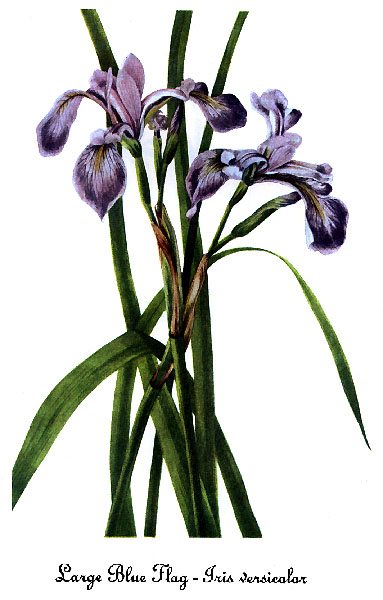Exercise 4.3: Colored Pencil Illustration: Iris sp.
Exercise 4.3: Colored Pencil Illustration: Iris sp.
For this exercise we are creating a portfolio piece: Iris species with colored pencils. Irises are an interesting subject with beautiful flowers, making them ideal to illustrate with colored pencils. Irises can easily be found outside during the spring and early summer, depending on your region or location, or at a floral shop. If you live in an area of the world without this particular flower either available in gardens or at the florist, of course, feel free to find a suitable substitute. Examples might include orchids, alstroemerias, lilies, calla lilies, and cannas.
There are several species of Iris sp., including Blue Flag and Siberian. We will focus on a single iris flower with its foliage and possibly its tuber, if it is available to you.
Plan out your drawing. Start by using your pencil for the overall layout of each part of the plant that will be shown. First, begin with the main focus, the flower and stem. The flower is typically in the center of the illustration, with the foliage on either side though occasionally illustrators may place the tuber and stem in the center. Any extra features that may be included will be in either side of the main flower/stem. Keep in mind your overall composition when laying these components out. Some additional details that may be included with this type of floral representation are the pre-flower bud, dead flower, tuber (roots), seeds, ovaries, anthers and stamens. With other types of plants, different components may be shown. These extra items are not required for this illustration, although if you have access to a live iris plant, you may want to illustrate the tuber.
Before you begin your illustration, consider conducting some research on your iris (or other subject). This will help you really understand the parts to the plant. We like to emphasize engaging in this practice before every finalized botanical illustration on your specific study. Below is a detailed description for Iris versicolor:
"I. versicolor is a perennial herb, growing 10–80 centimetres high. This iris tends to form large clumps from thick, creeping rhizomes. The unwinged, erect stems generally have basal leaves that are more than 1 cm wide. Leaves are folded on the midribs so that they form an overlapping flat fan. The well-developed blue flower has 6 petals and sepals spread out nearly flat and have two forms. The longer sepals are hairless and have a greenish-yellow blotch at their base. The inferior ovary is bluntly angled. Flowers are usually light to deep blue (purple and violet are not uncommon) and bloom during May to July. Fruit is a 3-celled, bluntly angled capsule. The large seeds can be observed floating in fall. The species has been implicated in several poisoning cases of humans and animals who consumed the rhizomes, which have been found to contain a glycoside, iridin. The sap can cause dermatitis in susceptible individuals." (ROM Field Guide to Wildflowers of Ontario. Toronto:Royal Ontario Museum, 2004.)


Before beginning with color, take a step back from your pencil sketch to evaluate the overall composition and scale.
After all components are sketched in, start coloring in your base colors. The majority of the colors will likely be greens. Try sketching some green testing squares on a draft paper to find the correct green, since our eye sees such a plethora of subtle differences in this color.
Blend your colored pencils. Prismacolor pencils are perfect for blending and create almost a watercolor style. Since this is a final portfolio piece, allow for a considerable portion of time for this assignment. As a reminder, please feel free to post questions to others in the forum.
After you have completed your work, sign and date your work. Below your illustration, neatly write the scientific and common name of your specimen. Scan and submit for grading.